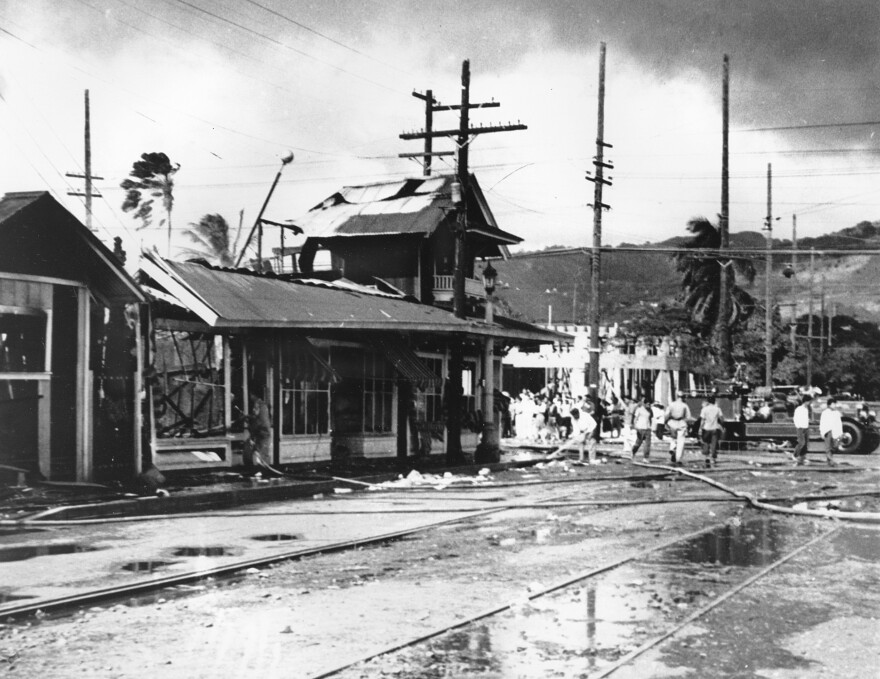Eighty-one years ago on Wednesday, the Japanese Navy launched a surprise attack on Pearl Harbor, bringing the United States into World War II. Locally, the changes brought by the coming war were immediately felt.
As part of an ongoing project with the University of Hawaiʻi at Mānoa Center for Oral History, we are hearing the voices of those who experienced that day in Honolulu.
Ethnic studies professor Ty Kāwika Tengan shares firsthand accounts from Helene Minehara and Akira Otani. They were interviewed in March 2011 as part of the Densho Visual History Collection.
On Dec. 7, 1941, the Japanese Navy launched a surprise military attack against the U.S. naval base at Pearl Harbor located on Oʻahu. The attack was intended to neutralize the U.S. Pacific Fleet as the Japanese expanded throughout the Pacific region. Despite numerous historical precedents for unannounced military action, the lack of any formal warning by Japan led President Franklin D. Roosevelt to proclaim Dec. 7, 1941, "a date which will live in infamy."
The attack on Pearl Harbor brought America into World War II and raised suspicions of the large Japanese communities on the West Coast and in Hawaiʻi. However, the changes brought by war were immediately felt by residents of Oʻahu in the hours and days following the attack.
Born April 30, 1925, in Waipahu, Hawaiʻi, Helene Minehira witnessed the attack. Due to the proximity of their home to the harbor, her family was forced to evacuate from ʻEwa Beach and had to live temporarily in a Japanese language school before moving to another home.

Minehira: See, we lived in ʻEwa, so we heard this sound coming, sounded like a swarm of bees, you know that humming sound? As soon as they got closer, the house started to vibrate, so by the time it did, the planes were right above our head. We saw that round red circle, and we didn't think it was war. We thought it was maneuvers because nobody had any feeling that we'll be ever invaded by Japanese, right? They were already fighting someone else, so we didn't think about it. Then when you saw the bombs, the explosion and the smoke and the sound of that plane just, I'm telling you it was really scary. And then it just went on for a while. Then we heard this terrible sound coming down from the street. Somebody was clanking something. We could hear it. Then we could hear somebody yelling and it was Mr. Zane and Mr. Kakazu. They came up and say, "War, war," and that's when we believed that something was happening. My dad says, "Don't worry. You girls got us. We'll protect you." "Shinpai suru na," he said. "Don't worry," he said.

Another witness to the Pearl Harbor attack was Nisei Akira Otani. Born Jan. 26, 1921, in Honolulu, Otani grew up in Honolulu where his father owned a successful fish auction business. Otani’s experience captured the sentiments of disbelief that many Hawai‘i residents felt after witnessing the Japanese attack.
Otani: Yes, we saw it very clearly, we're not very far from Pearl Harbor. We could hear all the noises, we could see all the black smoke and all the thundering noises of all the explosion of the ships. And then I was looking up in the sky, you could see the planes, you could see all the explosion of shots, I even got to see two Japanese planes. It's unbelievable, as far as I'm concerned, I never expected anything like this, it was a shock, hard to believe that something like that was happening.

Interviewer Tom Ikeda: At this point was there any concern on your part about your father being Japanese and anything might happen to him?
Otani: No, no concern, so all we do then of course then naturally everybody turn on the radio, we got a report that this was a real thing, that Japan... we're under attack by the Japanese. It's hard to imagine but at the same time, we didn't feel good. We got very mad at the Japanese for having attacked us because, you know, there's no distinction being made that the Japanese or we were all Americans, well, people living in Hawaiʻi, and we were being attacked period, you know.
After the bombing of Pearl Harbor, Otani volunteered for the Hawaiʻi Territorial Guard. Eventually, he joined the U.S. Army and served in Japan during the U.S. occupation. He returned to Honolulu and worked to expand the family's fish auction.
———
Helene J. Minehira was interviewed by Tom Ikeda and Kelli Nakamura on March 2, 2011. Akira Otani was interviewed by Tom Ikeda on March 3, 2011. Both interviews are part of the Densho Visual History Collection. The Densho Digital Repository, a multi-partner initiative of Densho: The Japanese American Legacy Project, contains oral history interviews, photographs, documents, and other materials relating to the Japanese American experience. Additional information on the project is available at www.densho.org.
This collaboration is supported by the SHARP Initiative of the National Endowment for the Humanities through the American Council of Learned Societies.





